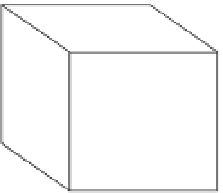Geoscience Reference
In-Depth Information
achieve notational brevity. The strain tensor is related to
its components by
pressure
P
, and we consider no change in the fluid pres-
sure
p
=0. In this case, the bulk deformation is given by
P
K
=
ε
ij
x
i
x
j
1 121
ε
ε
kk
P
,0
≡∇
u
P
,0 =
−
1 122
where
x
i
(
i
= 1, 2, 3) denote the basis vectors of the Car-
tesian framework of reference (
x
i
x
j
=
where the drained bulk modulus of the porous material
is defined by
δ
ij
denotes the Kronecker delta) and
a b
represents the
tensorial product between vectors
a
and
b
.
We first consider two states, E1 and E2, that will be
combined soon to determine the effective pressure in
a porous material. In state E1, we apply a confining
δ
ij
where
1
K
=
1
V
∂V
∂
−
1 123
P
p
=0,
T
and
T
denotes temperature. In state E2, we apply a
confining stress
P
, and we imposed a fluid pressure equal
to the confining stress
p
=
P
. In this second state, the
deformation of the material is controlled by the stiffness
of the solid phase (not by the stiffness of the skeleton).
Therefore, we have
X
3
X
1
O
P
K
S
ε
kk
P
=
p
,
p
≡∇
u
P
=
p
,
p
=
−
1 124
X
2
T
31
where
K
S
, the drained bulk modulus of the solid phase
(e.g., silica), is defined by
T
11
1
K
S
=
−
1
V
∂
V
∂
1 125
P
p
=
P
,
T
T
21
Now, we can describe the general bulk deformation of
a porous material in state E as the linear superposition of
the two states E1 and E2 as shown in Figure 1.26. This
can be written as
Figure 1.25
Definition of the stress tensor components on a cube
of an elastic material. Each component defines a force on one of
the face of the cube in a certain direction. These forces are
imposed from the external world.
P
P
-
p
P=p
Solid
Solid
Solid
p
=
+
p
p
= 0
E
(
P
,
p
)
E
1
(
P
-
p
, 0)
E
2
(
P
=
p, p
)
Figure 1.26
Application of the superposition principle used to determine the effective pressure law in a linear poroelastic material. The
porous material is composed of a solid phase with an interconnected pore space, which is also connected to the external world. In the
general case, we impose a confining pressure
P
to the porous material, and there is an internal pressure corresponding to the pore fluid
pressure
p
. The general case can be considered as the superposition of two states E1 and E2. In the first state, we apply a confining
pressure
P
-
p
, and therefore is no internal pressure in the pores. In state E2, we apply a confining pressure that is equal to the fluid
pressure.



































































































